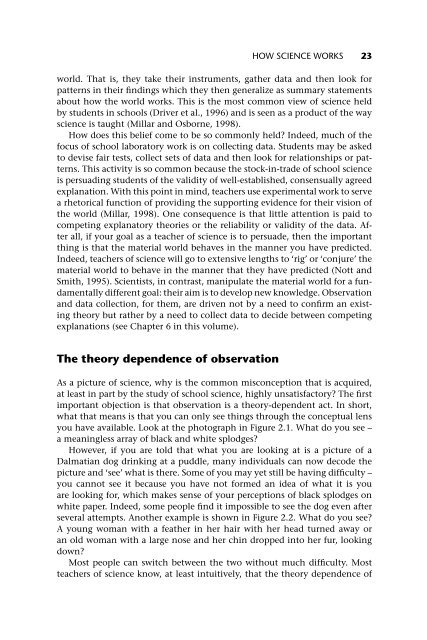good-practice-in-science-teaching-what-research-has-to-say
good-practice-in-science-teaching-what-research-has-to-say
good-practice-in-science-teaching-what-research-has-to-say
Create successful ePaper yourself
Turn your PDF publications into a flip-book with our unique Google optimized e-Paper software.
HOW SCIENCE WORKS 23<br />
world. That is, they take their <strong>in</strong>struments, gather data and then look for<br />
patterns <strong>in</strong> their f<strong>in</strong>d<strong>in</strong>gs which they then generalize as summary statements<br />
about how the world works. This is the most common view of <strong>science</strong> held<br />
by students <strong>in</strong> schools (Driver et al., 1996) and is seen as a product of the way<br />
<strong>science</strong> is taught (Millar and Osborne, 1998).<br />
How does this belief come <strong>to</strong> be so commonly held Indeed, much of the<br />
focus of school labora<strong>to</strong>ry work is on collect<strong>in</strong>g data. Students may be asked<br />
<strong>to</strong> devise fair tests, collect sets of data and then look for relationships or patterns.<br />
This activity is so common because the s<strong>to</strong>ck-<strong>in</strong>-trade of school <strong>science</strong><br />
is persuad<strong>in</strong>g students of the validity of well-established, consensually agreed<br />
explanation. With this po<strong>in</strong>t <strong>in</strong> m<strong>in</strong>d, teachers use experimental work <strong>to</strong> serve<br />
a rhe<strong>to</strong>rical function of provid<strong>in</strong>g the support<strong>in</strong>g evidence for their vision of<br />
the world (Millar, 1998). One consequence is that little attention is paid <strong>to</strong><br />
compet<strong>in</strong>g explana<strong>to</strong>ry theories or the reliability or validity of the data. After<br />
all, if your goal as a teacher of <strong>science</strong> is <strong>to</strong> persuade, then the important<br />
th<strong>in</strong>g is that the material world behaves <strong>in</strong> the manner you have predicted.<br />
Indeed, teachers of <strong>science</strong> will go <strong>to</strong> extensive lengths <strong>to</strong> ‘rig’ or ‘conjure’ the<br />
material world <strong>to</strong> behave <strong>in</strong> the manner that they have predicted (Nott and<br />
Smith, 1995). Scientists, <strong>in</strong> contrast, manipulate the material world for a fundamentally<br />
different goal: their aim is <strong>to</strong> develop new knowledge. Observation<br />
and data collection, for them, are driven not by a need <strong>to</strong> confirm an exist<strong>in</strong>g<br />
theory but rather by a need <strong>to</strong> collect data <strong>to</strong> decide between compet<strong>in</strong>g<br />
explanations (see Chapter 6 <strong>in</strong> this volume).<br />
The theory dependence of observation<br />
As a picture of <strong>science</strong>, why is the common misconception that is acquired,<br />
at least <strong>in</strong> part by the study of school <strong>science</strong>, highly unsatisfac<strong>to</strong>ry The first<br />
important objection is that observation is a theory-dependent act. In short,<br />
<strong>what</strong> that means is that you can only see th<strong>in</strong>gs through the conceptual lens<br />
you have available. Look at the pho<strong>to</strong>graph <strong>in</strong> Figure 2.1. What do you see –<br />
a mean<strong>in</strong>gless array of black and white splodges<br />
However, if you are <strong>to</strong>ld that <strong>what</strong> you are look<strong>in</strong>g at is a picture of a<br />
Dalmatian dog dr<strong>in</strong>k<strong>in</strong>g at a puddle, many <strong>in</strong>dividuals can now decode the<br />
picture and ‘see’ <strong>what</strong> is there. Some of you may yet still be hav<strong>in</strong>g difficulty –<br />
you cannot see it because you have not formed an idea of <strong>what</strong> it is you<br />
are look<strong>in</strong>g for, which makes sense of your perceptions of black splodges on<br />
white paper. Indeed, some people f<strong>in</strong>d it impossible <strong>to</strong> see the dog even after<br />
several attempts. Another example is shown <strong>in</strong> Figure 2.2. What do you see<br />
A young woman with a feather <strong>in</strong> her hair with her head turned away or<br />
an old woman with a large nose and her ch<strong>in</strong> dropped <strong>in</strong><strong>to</strong> her fur, look<strong>in</strong>g<br />
down<br />
Most people can switch between the two without much difficulty. Most<br />
teachers of <strong>science</strong> know, at least <strong>in</strong>tuitively, that the theory dependence of


